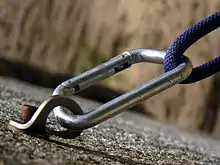Bolt (climbing)
In rock climbing, a bolt is a permanent anchor fixed into a hole drilled in the rock as a form of protection. Most bolts are either self-anchoring expansion bolts or fixed in place with liquid resin.

While bolts are commonplace in rock and gym climbing there is no universal vocabulary to describe them. Generally, a bolt hanger or a fixed hanger is a combination of a fixed bolt and a specialized stainless steel hanger designed to accept a carabiner, whereas in certain regions a bolt runner or a carrot describes a hangerless bolt (where the climber must provide their own hanger bracket and sometimes lock nut). A ring bolt has a loop on one end so it presents as a U-shape embedded in the wall.
A climbing rope is then clipped into the carabiner. Generally quickdraws or slings are employed between bolt hangers and the rope to reduce drag when ascending, belaying and rappelling.
Bolts are used in sport climbing as a backup to catch a fall, but not to aid ascent, whereas in aid climbing they can be used to aid ascent.
Lifespan
Bolts are subject to corrosion and stress and the combination tends to cause stress corrosion cracking. A bolt in an aggressive tropical climate such as Thailand can fail in as little as 18 months. In more temperate regions, a lifespan of 10–15 years is typical. There is a lack of effective standards and maintenance in many places but new materials such as titanium are now being used to improve the expected lifespan.[1]
See also
References
- Jeff Achey (23 April 2014), "Built to Last? The Hidden Dangers Of Climbing Bolts", Climbing